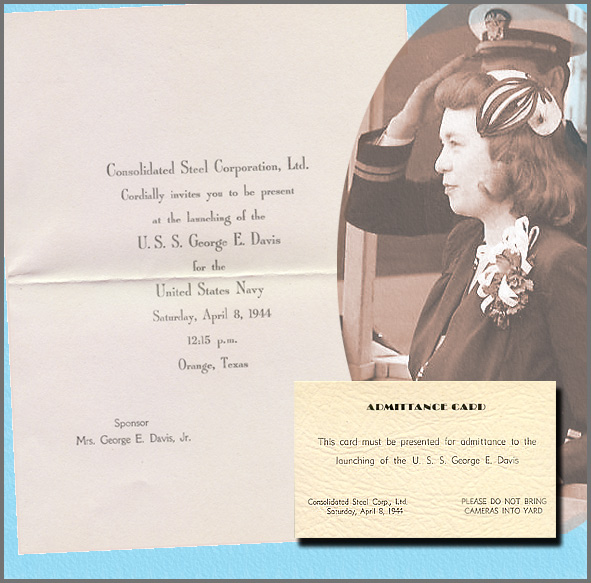Davis Collection Invitation to Christening and Launch of the George E. Davis DE-357
| Dateline Orange, Texas Saturday 8 April, 1944 You are invited to the Christening and Launch of a new ship. Background: On September 9, 1940, a federal contract worth $82 million was issued to the Consolidated Steel Company to construct 12 Fletcher class naval destroyers in Orange, Texas. This and other contracts coupled with the subsequent building of major shipyard facilities along the city’s riverfront lifted the city out of a prolonged and deep economic decline which began in the early 1930s with the closing of area sawmills. By 1946 all 12 destroyers and over four hundred other ships (Including the Davis, A Butler Class warship) had been completed here at a cost of over $876 million. |

Mrs. Jane Hine Davis, widow of George E. Davis Jr., and unidentified sailor watch as the George E. Davis DE357 is launched. Actual picture of the Launch Invitation and pass card.
|
The United States Navy In Orange, Texas The United States Navy has long been associated with Orange, TX. In 1940, the Navy initiated what was to become a massive WWII shipbuilding program. This required the construction of a number of new shipyards. One of the locations selected for the new facilities was Orange, Texas. At the time, the Consolidated Western Steel Corp. was operating a small steel fabricating plant at the east end of Front Avenue. The Navy and Consolidated entered into a contract under which the Bureau of Ships would construct a shipyard adjacent to the existing CWS plant with Consolidated as the operator. It formed a subsidiary titled Consolidated Western Steel Corp., Shipbuilding Division, for that purpose. A combine known as Bechtel-McCone-Parsons was given a contract to build the facilities and construction began that year. The first unit of the yard was completed in 1941and Consolidated immediately began work on the first ships. The Japanese bombing of Pearl Harbor on December 7, 1941 and the declaration of War by the United States upon Japan, Germany, and Italy greatly accelerated the pace of the Navy shipbuilding program. The yards at Orange were enlarged and employment there began climbing toward a peak of 20,000 workers. The first ship, USS Aulick, a Destroyer, was delivered in 1942. In all, the shipyards at Orange built 39 Destroyers, 93 Destroyer Escorts, and 106 landing craft, prior to the termination of the shipbuilding program in 1946. With the war almost over, the Navy chose Orange as the location of a major post-war fleet berthing operation. This required the construction of a number of piers on the Sabine River, just north of the shipyards. This activity was known first as the Texas Group, Atlantic Reserve Fleet. In 1960, the name was changed to Naval Inactive Ship Maintenance Facility. At the peak, about 250 mothballed vessels were stationed here. Forty of the ships were reactiviated during the Korean conflict. During the 1950’s part of the original shipyard facilities were sold to U.S. Steel Corporation, American Bridge Division, now known as U.S. Steel-Fabrication. In 1974, the Navy began phasing out the fleet berthing operation. By the latter part of that decade, all the ships were gone. Some were sold to foreign countries, some scraped, and the remainder are berthed at the National Defense Reserve Fleet, Beaumont, TX. Of the remaining facilities, some were acquired by U.S. Steel, others turned over to Lamar University at Orange, and the remaining piers and adjacent land were sold to the Orange County Navigation and Port District. The 16.5 acres that remain in the Navy’s hands are the site of the present Orange Naval Reserve Center. |